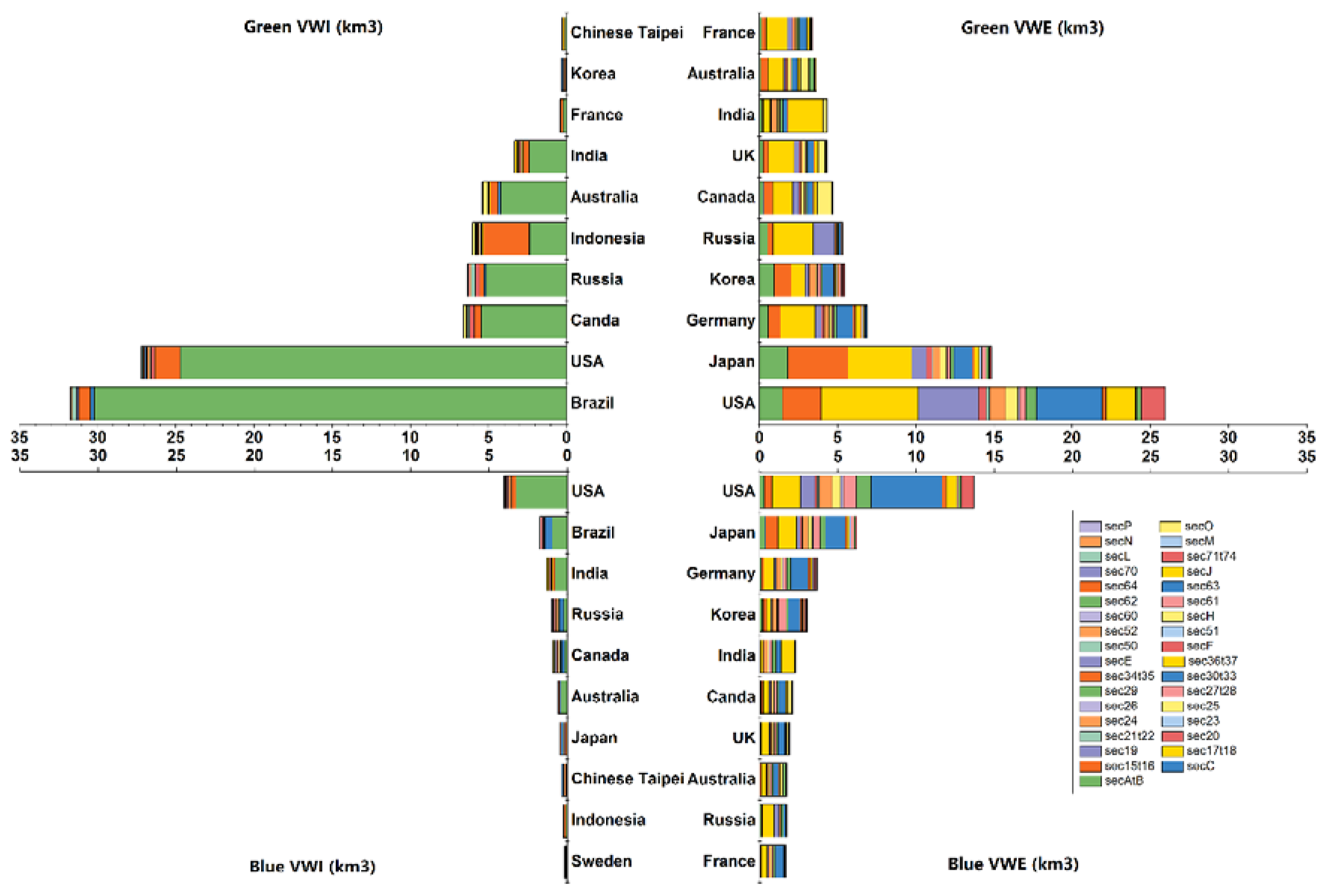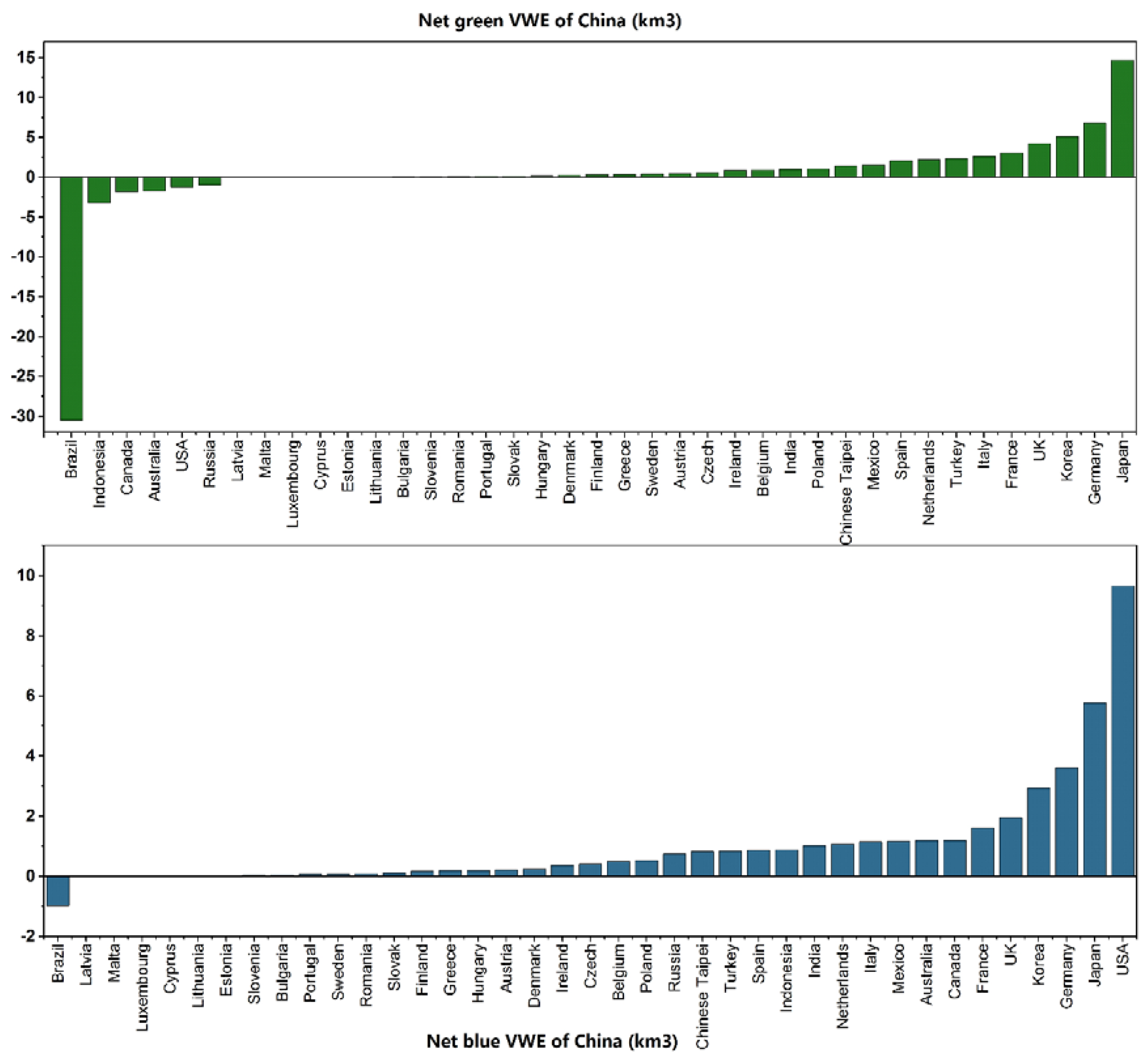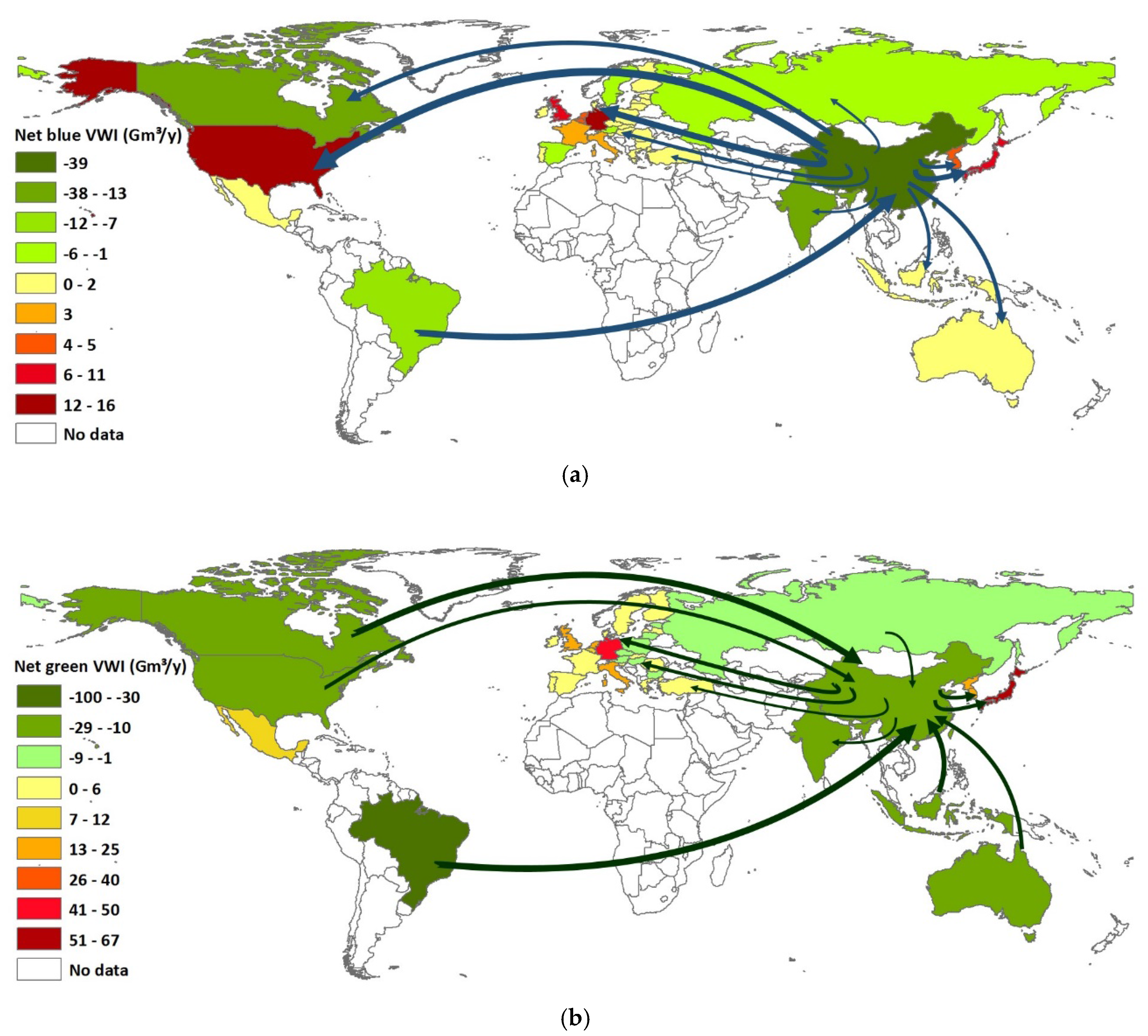Blue and Green Water Footprint Assessment for China—A Multi-Region Input–Output Approach
Abstract
:1. Introduction
2. Methodology and Data
2.1. Methodology
2.2. Data
3. Results
3.1. China’s Blue and Green Water Footprint from the Production Perspective
3.2. China’s Blue and Green Water Footprint from the Consumption Perspective
3.3. Net Blue and Green Virtual Water Flows of China
4. Discussion
5. Conclusions
Author Contributions
Funding
Acknowledgments
Conflicts of Interest
References
- World Economic Formum. GLOBAL Risks 2015. Available online: http://reports.weforum.org/global-risks-2015/ (accessed on 18 June 2018).
- National Data Bureau of Statistics of China. Available online: http://data.stats.gov.cn/easyquery.htm?cn=C01 (accessed on 25 June 2018).
- Udimal, T.B.; Zhuang, J.C.; Emmanuel Caesar, A.; Samuel, M.O. China’s water situation; the supply of water and the pattern of its usage. Int. J. Sustain. Dev. 2017, 6, 491–500. [Google Scholar] [CrossRef]
- Ridoutt, B.G.; Pfister, S. A revised approach to water footprinting to make transparent the impacts of consumption and production on global freshwater scarcity. Glob. Environ. Chang. 2010, 20, 113–120. [Google Scholar] [CrossRef]
- Munksgaard, J.; Wier, M.; Lenzen, M.; Dey, C. Using Input-Output Analysis to Measure the environmental pressure of consumption at different spatial levels. J. Ind. Ecol. 2005, 9, 169–185. [Google Scholar] [CrossRef]
- Hoekstra, A.Y.; Hung, P.Q. Virtual water trade: A quantification of virtual water flows between nations in relation to international crop trade. In Value of Water Research Report Series No. 11; UNESCO-IHE: Delft, The Netherlands, 2002. [Google Scholar]
- Chenoweth, J.; Hadjikakou, M.; Zoumides, C. Quantifying the human impact on water resources: A critical review of the water footprint concept. Hydrol. Earth Syst. Sci. 2014, 18, 2325–2342. [Google Scholar] [CrossRef] [Green Version]
- Mekonnen, M.M.; Hoekstra, A.Y. Global Gray Water Footprint and Water Pollution Levels Related to Anthropogenic Nitrogen Loads to Fresh Water. Environ. Sci. Technol. 2015, 49, 12860–12868. [Google Scholar] [CrossRef] [PubMed]
- Liu, W.; Antonelli, M.; Liu, X.; Yang, H. Towards improvement of grey water footprint assessment: With an illustration for global maize cultivation. J. Clean. Prod. 2017, 147, 1–9. [Google Scholar] [CrossRef]
- Zhuo, L.; Mekonnen, M.M.; Hoekstra, A.Y. The effect of inter-annual variability of consumption, production, trade and climate on crop-related green and blue water footprints and inter-regional virtual water trade: A study for China (1978–2008). Water Res. 2016, 94, 73–85. [Google Scholar] [CrossRef] [PubMed]
- Bosire, C.K.; Lannerstad, M.; Leeuw, J.D.; Krol, M.S.; Ogutu, J.O.; Ochungo, P.A.; Hoekstra, A.Y. Urban consumption of meat and milk and its green and blue water footprints—Patterns in the 1980s and 2000s for Nairobi, Kenya. Sci. Total Environ. 2017, 579, 786–796. [Google Scholar] [CrossRef] [PubMed]
- Civit, B.; Piastrellini, R.; Curadelli, S.; Arena, A.P. The water consumed in the production of grapes for vinification (Vitis vinifera). Mapping the blue and green water footprint. Ecol. Indic. 2018, 85, 236–243. [Google Scholar] [CrossRef]
- Hoekstra, A.Y.; Mekonnen, M.M. The water footprint of humanity. Proc. Natl. Acad. Sci. USA 2012, 109, 3232–3237. [Google Scholar] [CrossRef] [PubMed] [Green Version]
- Zhao, X.; Yang, H.; Yang, Z.; Chen, B.; Qin, Y. Applying the input-output method to account for WF and VWT in Haihe River Basin in China. Environ. Sci. Technol. 2010, 44, 9150–9156. [Google Scholar] [CrossRef] [PubMed]
- Pellicer-Martínez, F.; Martínez-Paz, J.M. Probabilistic evaluation of the water footprint of a river basin: Accounting method and case study in the Segura River Basin, Spain. Sci. Total Environ. 2018, 627, 28–38. [Google Scholar] [CrossRef] [PubMed]
- Serrano, A.; Guan, D.; Duarte, R.; Paavola, J. Virtual Water Flows in the EU27: A Consumption-based Approach. J. Ind. Ecol. 2016, 20, 547–558. [Google Scholar] [CrossRef] [Green Version]
- Gobin, A.; Kersebaum, K.C.; Eitzinger, J.; Trnka, M.; Hlavinka, P.; Takáč, J.; Kroes, J.; Ventrella, D.; Marta, A.D.; Deelstra, J.; et al. Variability in the water footprint of arable crop production across European regions. Water 2017, 9, 93. [Google Scholar] [CrossRef]
- Yang, Z.; Liu, H.; Xu, X.; Yang, T. Applying the Water Footprint and dynamic Structural Decomposition Analysis on the growing water use in China during 1997–2007. Ecol. Indic. 2016, 60, 634–643. [Google Scholar] [CrossRef]
- Zhao, X.; Chen, B.; Yang, Z.F. National water footprint in an input–output framework—A case study of China 2002. Ecol. Model. 2009, 220, 245–253. [Google Scholar] [CrossRef]
- Chouchane, H.; Krol, M.S.; Hoekstra, A.Y. Virtual water trade patterns in relation to environmental and socioeconomic factors: A case study for Tunisia. Sci. Total Environ. 2018, 613, 287–297. [Google Scholar] [CrossRef] [PubMed]
- Zoumides, C.; Bruggeman, A.; Hadjikakou, M.; Zachariadis, T. Policy-relevant indicators for semi-arid nations: The water footprint of crop production and supply utilization of Cyprus. Ecol. Indic. 2014, 43, 205–214. [Google Scholar] [CrossRef]
- Zhang, F.; Zhan, J.Y.; Li, Z.H.; Jia, S.Q.; Chen, S.J. Impacts of urban transformation on water footprint and sustainable energy in Shanghai, China. J. Clean. Prod. 2018, 190, 847–853. [Google Scholar] [CrossRef]
- Vanham, D.; Mak, T.N.; Gawlik, B.M. Urban food consumption and associated water resources: The example of Dutch cities. Sci. Total Environ. 2016, 565, 232–239. [Google Scholar] [CrossRef] [PubMed]
- Shi, J.; Liu, J.; Pinter, L. Recent evolution of China’s virtual water trade: Analysis of selected crops and considerations for policy. Hydrol. Earth Syst. Sci. 2014, 18, 1349–1357. [Google Scholar] [CrossRef] [Green Version]
- Hanasaki, N.; Kanae, S.; Oki, T. An integrated model for the assessment of global water resources-Part 2: Applications and assessments. Hydrol. Earth Syst. Sci. 2008, 12, 1027–1037. [Google Scholar] [CrossRef]
- Feng, K.; Chapagain, A.; Suh, S.; Pfister, S.; Hubacek, K. Comparison of bottom-up and top-down approaches to calculating the water footprints of nations. Econ. Syst. Res. 2011, 23, 371–385. [Google Scholar] [CrossRef]
- Yang, H.; Pfister, S.; Bhaduri, A. Accounting for a scarce resource: Virtual water and water footprint in the global water system. Curr. Opin. Environ. Sustain. 2013, 5, 599–606. [Google Scholar] [CrossRef]
- Malik, A.; McBain, D.; Wiedmann, T.O.; Lenzen, M.; Murray, J. Advancements in Input-Output Models and Indicators for Consumption-Based Accounting. J. Ind. Ecol. 2018, 1–18. [Google Scholar] [CrossRef]
- Zhao, C.; Chen, B.; Hayat, T.; Alsaedi, A.; Bashir, A. Driving force analysis of water footprint change based on extended STIRPAT model: Evidence from the Chinese agricultural sector. Ecol. Indic. 2014, 47, 43–49. [Google Scholar] [CrossRef]
- Zhuo, L.; Mekonnen, M.M.; Hoekstra, A.Y. Consumptive water footprint and virtual water trade scenarios for China—With a focus on crop production, consumption and trade. Environ. Int. 2016, 94, 211–223. [Google Scholar] [CrossRef] [PubMed]
- Zhuo, L.; Mekonnen, M.M.; Hoekstra, A.Y.; Wada, Y. Inter- and intra-annual variation of water footprint of crops and blue water scarcity in the Yellow River basin (1961–2009). Adv. Water Resour. 2016, 87, 29–41. [Google Scholar] [CrossRef]
- Cao, X.; Wu, M.; Shu, R.; Zhuo, L.; Chen, D.; Shao, G.; Guo, X.; Wang, W.; Tang, S. Water footprint assessment for crop production based on field measurements: A case study of irrigated paddy rice in East China. Sci. Total Environ. 2018, 610–611, 84–93. [Google Scholar]
- Zhang, Y.; Huang, K.; Ridoutt, B.G.; Yu, Y. Comparing volumetric and impact-oriented water footprint indicators: Case study of agricultural production in Lake Dianchi Basin, China. Ecol. Indic. 2018, 87, 14–21. [Google Scholar] [CrossRef]
- Wang, X.; Li, X.; Fischer, G.; Sun, L.; Tan, M.; Xin, L.; Liang, Z. Impact of the changing area sown to winter wheat on crop water footprint in the North China Plain. Ecol. Indic. 2015, 57, 100–109. [Google Scholar] [CrossRef] [Green Version]
- Wang, X.M.; Huang, K.; Yu, Y.J.; Hu, T.T.; Xu, Y.J. An input–output structural decomposition analysis of changes in sectoral water footprint in China. Ecol. Indic. 2016, 69, 26–34. [Google Scholar] [CrossRef]
- Oki, T.; Kanae, S. Virtual water trade and world water resources. Water Sci. Technol. 2004, 49, 203–209. [Google Scholar] [CrossRef] [PubMed]
- Chapagain, A.; Hoekstra, A.; Savenije, H. Water saving through international trade of agricultural products. Hydrol. Earth Syst. Sci. 2006, 10, 455–468. [Google Scholar] [CrossRef] [Green Version]
- Liu, J.; Zehnder, A.J.B.; Yang, H. Historical Trends in China’s Virtual Water Trade. Water Int. 2007, 32, 78–90. [Google Scholar] [CrossRef]
- Chen, W.; Wu, S.; Lei, Y.; Li, S. Virtual water export and import in china’s foreign trade: A quantification using input-output tables of China from 2000 to 2012. Resour. Conserv. Recyl. 2018, 132, 278–290. [Google Scholar] [CrossRef]
- Dalin, C.; Konar, M.; Hanasaki, N.; Rinaldo, A.; Rodriguez-Iturbe, I. Evolution of the global virtual water trade network. Proc. Natl. Acad. Sci. USA 2012, 109, 5989–5994. [Google Scholar] [CrossRef] [PubMed] [Green Version]
- Lenzen, M.; Moran, D.; Bhaduri, A.; Kanemoto, K.; Bekchanov, M.; Geschke, A.; Foran, B. International trade of scarce water. Ecol. Econ. 2013, 94, 78–85. [Google Scholar] [CrossRef]
- Timmer, M.P.; Dietzenbacher, E.; Los, B.; Stehrer, R.; de Vries, G.J. An illustrated user guide to the world input–output database: The case of global automotive production. Rev. Int. Econ. 2015, 23, 575–605. [Google Scholar] [CrossRef]
- Peters, G.P.; Hertwich, E.G. CO2 embodied in international trade with implications for global climate policy. Environ. Sci. Technol. 2008, 42, 1401–1407. [Google Scholar] [CrossRef] [PubMed]
- Zhao, X.; Liu, J.; Liu, Q.; Tillotson, M.R.; Guan, D.; Hubacek, K. Physical and virtual water transfers for regional water stress alleviation in China. Proc. Natl. Acad. Sci. USA 2015, 112, 1031–1035. [Google Scholar] [CrossRef] [PubMed] [Green Version]
- Genty, A. Final Database of Environmental Satellite Accounts: Technical Report on Their Compilation. WIOD Deliverable 4.6, Documentation. 2012. Available online: www.wiod.org/publications/source_docs/Environmental_Sources.pdf (accessed on 17 April 2018).
- Liu, J.G.; Yang, H. Spatially explicit assessment of global consumptive water uses in cropland: Green and blue water. J. Hydrol. 2010, 384, 187–197. [Google Scholar] [CrossRef]
- Dalin, C.; Hanasaki, N.; Qiu, H.G.; Mauzerall, D.L.; Rodriguez-Iturbe, I. Water resources transfers through Chinese interprovincial and foreign food trade. Proc. Natl. Acad. Sci. USA 2014, 111, 9774–9779. [Google Scholar] [CrossRef] [PubMed] [Green Version]
- Carter, C.A.; Rozelle, S. Will China’s agricultural trade reflect its comparative advantage? In China’s Food and Agriculture: Issues for the 21st Century; Gale, F., Ed.; U.S. Department of Agriculture: Washington, DC, USA, 2001; pp. 27–30. [Google Scholar]
- Dalin, C.; Suweis, S.; Konar, M.; Hanasaki, N.; Rodriguez-Iturbe, I. Modeling past and future structure of the global virtual water trade network. Geogr. Res. Lett. 2012, 39, L24402. [Google Scholar] [CrossRef]
- Wiedmann, T. A review of recent multi-region input–output models used for consumption-based emission and resource accounting. Ecol. Econ. 2009, 69, 211–222. [Google Scholar] [CrossRef]



| Sector Abbreviation | Sector Full Name | IWF Unit: km3 | VWI Unit: km3 | VWE Unit: km3 | WFP Unit: km3 | WFC Unit: km3 |
|---|---|---|---|---|---|---|
| secAtB | Agriculture, Hunting, Forestry, and Fishing | 376.5 | 81.3 | 10.8 | 387.3 | 457.8 |
| secC | Mining and Quarrying | 0.6 | 1.7 | 0.4 | 1.0 | 2.3 |
| sec15t16 | Food, Beverages, and Tobacco | 204.1 | 8.0 | 14.6 | 218.7 | 212.1 |
| sec17t18 | Textiles and Textile Products | 24.9 | 0.5 | 38.0 | 62.9 | 25.4 |
| sec19 | Leather, Leather and Footwear | 12.4 | 0.3 | 11.5 | 23.9 | 12.7 |
| sec20 | Wood and Products of Wood and Cork | 1.0 | 1.1 | 2.1 | 3.1 | 2.1 |
| sec21t22 | Pulp, Paper, Paper, Printing, and Publishing | 0.4 | 1.2 | 0.8 | 1.2 | 1.6 |
| sec23 | Coke, Refined Petroleum, and Nuclear Fuel | 0.2 | 0.0 | 0.1 | 0.3 | 0.2 |
| sec24 | Chemicals and Chemical Products | 3.8 | 1.5 | 8.0 | 11.8 | 5.3 |
| sec25 | Rubber and Plastics | 1.4 | 0.2 | 4.3 | 5.7 | 1.6 |
| sec26 | Other Non-Metallic Mineral | 0.3 | 0.1 | 1.2 | 1.5 | 0.4 |
| sec27t28 | Basic Metals and Fabricated Metal | 3.2 | 1.0 | 5.1 | 8.3 | 4.2 |
| sec29 | Machinery, Nec | 16.5 | 0.5 | 5.5 | 22.0 | 17.0 |
| sec30t33 | Electrical and Optical Equipment | 13.0 | 1.0 | 25.3 | 38.3 | 14.0 |
| sec34t35 | Transport Equipment | 16.2 | 0.3 | 2.4 | 18.6 | 16.5 |
| sec36t37 | Manufacturing, Nec; Recycling | 1.8 | 0.3 | 8.6 | 10.4 | 2.1 |
| secE | Electricity, Gas and Water Supply | 10.6 | 0.1 | 0.4 | 11.0 | 10.7 |
| secF | Construction | 126.5 | 0.0 | 0.4 | 126.9 | 126.5 |
| sec50 | Sale, Maintenance and Repair of Motor Vehicles and Motorcycles; Retail Sale of Fuel | 0.0 | 0.0 | 0.0 | 0.0 | 0.0 |
| sec51 | Wholesale Trade and Commission Trade, Except of Motor Vehicles and Motorcycles | 9.3 | 0.1 | 0.9 | 10.2 | 9.4 |
| sec52 | Retail Trade, Except of Motor Vehicles and Motorcycles; Repair of Household Goods | 1.9 | 0.0 | 0.4 | 2.3 | 1.9 |
| secH | Hotels and Restaurants | 34.7 | 0.9 | 3.9 | 38.6 | 35.6 |
| sec60 | Inland Transport | 1.8 | 0.2 | 0.4 | 2.2 | 2.0 |
| sec61 | Water Transport | 0.4 | 0.0 | 1.0 | 1.4 | 0.4 |
| sec62 | Air Transport | 0.2 | 0.0 | 1.5 | 1.7 | 0.2 |
| sec63 | Other Supporting and Auxiliary Transport Activities; Activities of Travel Agencies | 2.3 | 0.0 | 0.5 | 2.8 | 2.3 |
| sec64 | Post and Telecommunications | 3.2 | 0.0 | 0.3 | 3.5 | 3.2 |
| secJ | Financial Intermediation | 2.7 | 0.0 | 0.0 | 2.7 | 2.7 |
| sec70 | Real Estate Activities | 4.4 | 0.0 | 0.0 | 4.4 | 4.4 |
| sec71t74 | Renting of M&Eq and Other Business Activities | 5.4 | 0.2 | 3.6 | 9.0 | 5.6 |
| secL | Public Admin and Defence; Compulsory Social Security | 24.6 | 0.1 | 0.0 | 24.6 | 24.7 |
| secM | Education | 17.3 | 0.0 | 0.0 | 17.3 | 17.3 |
| secN | Health and Social Work | 21.3 | 0.0 | 0.1 | 21.4 | 21.3 |
| secO | Other Community, Social, and Personal Services | 10.5 | 0.1 | 0.9 | 11.4 | 10.6 |
| secP | Private Households with Employed Persons | 0.0 | 0.0 | 0.0 | 0.0 | 0.0 |
| sum | 953.4 | 100.7 | 153.0 | 1106.4 | 1054.1 |
© 2018 by the authors. Licensee MDPI, Basel, Switzerland. This article is an open access article distributed under the terms and conditions of the Creative Commons Attribution (CC BY) license (http://creativecommons.org/licenses/by/4.0/).
Share and Cite
Hou, S.; Liu, Y.; Zhao, X.; Tillotson, M.R.; Guo, W.; Li, Y. Blue and Green Water Footprint Assessment for China—A Multi-Region Input–Output Approach. Sustainability 2018, 10, 2822. https://doi.org/10.3390/su10082822
Hou S, Liu Y, Zhao X, Tillotson MR, Guo W, Li Y. Blue and Green Water Footprint Assessment for China—A Multi-Region Input–Output Approach. Sustainability. 2018; 10(8):2822. https://doi.org/10.3390/su10082822
Chicago/Turabian StyleHou, Siyu, Yu Liu, Xu Zhao, Martin R. Tillotson, Wei Guo, and Yiping Li. 2018. "Blue and Green Water Footprint Assessment for China—A Multi-Region Input–Output Approach" Sustainability 10, no. 8: 2822. https://doi.org/10.3390/su10082822





